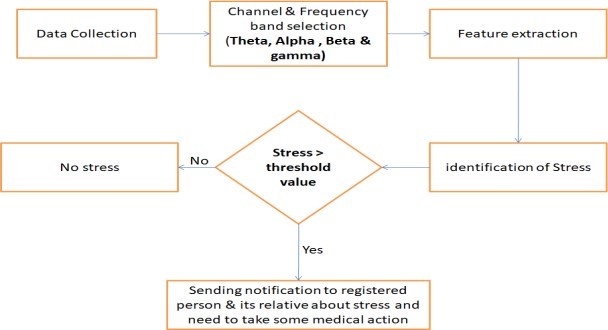EEG based Stress Analysis through Feature Extraction
Main Article Content
Abstract
The diagnosis of Stress relies virtually solely on doctor-patient conversation and scale analysis, which includes problems such as patient denial, insensitivity, subjective biases, and inaccuracy. Improving the accuracy of Stress diagnosis and therapy necessitates the development of an objective, computerized system for predicting clinical outcomes. Using the modification of EEG data and machine learning techniques, this study attempts to improve the recognition of Stress. The EEG data of 10 volunteers were acquired using a Narosky device during an experiment, including emotive facial stimuli. Psychiatrists used the EEG signal as the criterion for diagnosis of Stress in patients. The different approaches processed the features: machine learning and deep learning. Significant outcomes are achieved using PCA, ICA & EMD for BCI applications. SVM empowers a developer with several advantages: PCA exhibits excellent generalization properties, with stress & pressure detection using EEG Signals. If the signals are negative, the impact of overtraining is sensitive to the curse-of- dimensionality. These advantages were achieved by using EEG signals to detect Stress. The experimental analysis gives some overview of all different approaches, which depend on frequency domain analysis with 14 fourteen-channel EEG signals with reasonable accuracy.
Article Details
References
Marcel Trotzek , Sven Koitka , and Christoph M. Friedrich, “Utilizing Neural Networks and Linguistic Metadata for Early Detection of Stress Indications in Text Sequences”, IEEE TRANSACTIONS ON KNOWLEDGE AND DATA ENGINEERING, VOL. 32, NO. 3, MARCH 2020.
Systems, C., “ EEG-Based stress detection system using human emotions”, (2018), 10,2360–2370.
Thi, T., Pham, D., Kim, S., Lu, Y., Jung, S., Won, C., “Facial Action Units-Based Image Retrieval for Facial Expression Recognition”, IEEE Access, 7, 5200– 5207.https://doi.org/10.1109/ACCESS.2 018.2889852 , (2019).
N.d. ,“shocking statistics of workplace stress you never knew - harish saras.” accessed february 1, 2019. Https://www.harishsaras.com/stress- management/shocking-statistics-of- workplace-stress/.
Kakulapati, V., Singh Gill, G. ., R., C. ., Srivastava, S. ., Sharma, M. ., & Kumar , V. . (2023). Importance of Artificial Intelligence in Neural Network: Speech Signal Segmentation Using K-Means Clustering with Kernelized Deep Belief Networks. International Journal of Intelligent Systems and Applications in Engineering, 11(3s), 144–149. Retrieved from https://ijisae.org/index.php/IJISAE/article/view/2552
Viegas, carla, and roymaxion , “towards independent stress detection: a dependent model using facial action units.” 2018 international conference on content-based multimedia indexing (cbmi), 1–6.
Woo, seong-woo, “classification of stress and non-stress condition using functional near-infrared spectroscopy.” 2018 18th international conference on control, automation and systems (iccas), no. Iccas: 1147–51.
Wan-Young Chung, Teak-Wei Chong, and Boon-Giin Lee ,” METHODS TO DETECT AND REDUCE DRIVER STRESS: A REVIEW,” International Journal of Automotive Technology, Vol. 20, No. 5, pp. 1051-1063 (2019) DOI 10.1007/s12239-019-0099-3.
“Shocking Statistics of Workplace Stress You Never Knew - Harish Saras.” n.d. Accessed February 1, 2019. https://www.harishsaras.com/stress- /shocking-statistics-of- workplace-stress/.
M. Tarun Kumar, R. Sandeep Kumar, K. Praveen Kumar, S. Prasanna, G. Shiva,” Health Monitoring and Stress Detection System,” an International Research Journal of Engineering and Technology (IRJET) Volume: 06 Issue: 03 | Mar 2019.
Kevin Harris, Lee Green, Juan Garcia, Juan Castro, Juan González. Intelligent Personal Assistants in Education: Applications and Challenges. Kuwait Journal of Machine Learning, 2(2). Retrieved from http://kuwaitjournals.com/index.php/kjml/article/view/185
Luis G. Hernández , Oscar Martinez Mozos, José M. Ferrández and Javier M. Antelis,” EEG-Based Detection of Braking Intention Under Different Car Driving Conditions,” Frontiers in Neuroinformatics, vol. 12, May 2018.
Khalid masood and mohammed a. Alghamdi,” modeling mental Stress Using a Deep Learning Framework,” IEEE Access Vol.7 , 2019.

